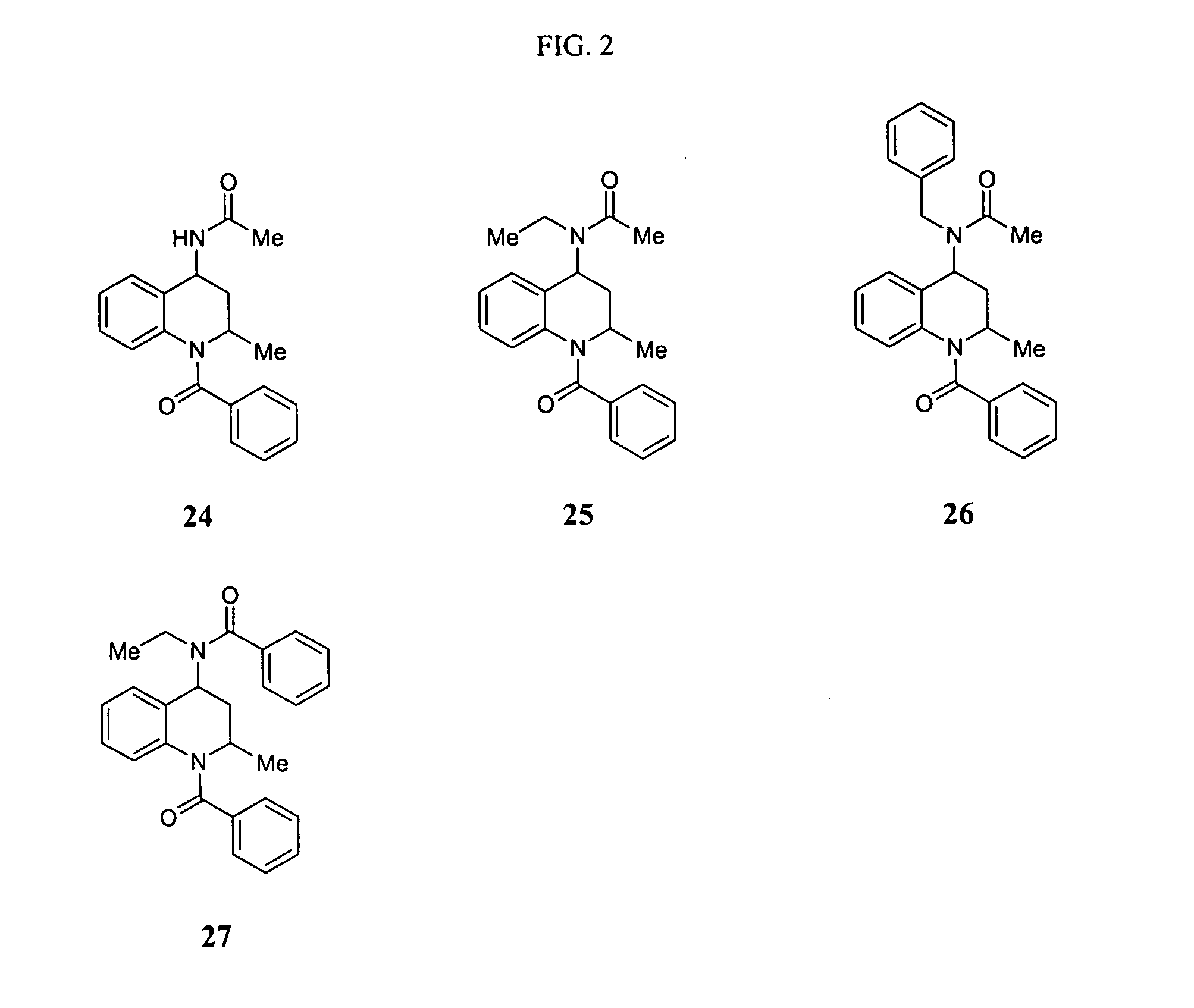Asthma and allergic inflammation modulators
a technology of allergic inflammation and modulator, which is applied in the field of gprotein coupled receptors, can solve the problems of pain, function loss, tissue or organ damage,
- Summary
- Abstract
- Description
- Claims
- Application Information
AI Technical Summary
Benefits of technology
Problems solved by technology
Method used
Image
Examples
example 1
This example illustrates the preparation of compound 4 from aniline and acetaldehyde.
Step a. Treatment with ethanol at r.t. for 3 days according to the procedure described in Funabashi et al. (1969) Bull. Chem. Soc. Jpn. 42:2885-2894 afforded a mixture of compound 1 and the trans isomer. Compound 1: 1H NMR (CDCl3) δ 7.38 (d, 1H, J=7.7 Hz), 7.20 (m, 2H), 7.04 (m, 1H), 6.70 (m, 4H), 6.51 (d, 1H, J=8.0 Hz), 4.83 (m, 1H), 3.85 (br s, 2H), 3.64 (m, 1H), 2.38 (m, 1H), 1.52 (t, 1H, J=12.4 Hz), 1.23 (d, 3H, J=6.2 Hz). MS (ESI+) 239.1 [MH]+.
Step b. Benzoyl chloride (0.36 mL, 3.12 mmol) was added to a mixture of 1 (675 mg, 2.84 mmol) and triethylamine (0.44 mL, 3.12 mmol) in dichloromethane (5 mL) at 0° C. The mixture was stirred at r.t. for 2 days and treated with dichloromethane (50 mL) and saturated aqueous sodium bicarbonate (50 mL). The organic layer was separated, dried with sodium sulfate and concentrated. The residue was washed with ether to give compound 2. 1H NMR (CDCl3) δ 7.4...
example 2
This example illustrates the preparation of compound 9 from aniline and ethyl acetoacetate.
Step a. Sodium triacetoxyborohydride (32 g, 150 mmol) was added to a mixture of aniline (9.1 mL), ethyl acetylacetate (12.7 mL, 100 mmol), and acetic acid (7.4 mL, 130 mmol) in 1,2-dichloroethane at r.t. The mixture was stirred at r.t. for 16 h and treated with dichloromethane (500 mL) and saturated aqueous sodium carbonate (500 mL). The organic layer was separated, dried with sodium sulfate and concentrated. The residue was used in the next step without further purification.
Step b. A mixture of the product of step a (3 g) and PPA (41 g) was heated to 110° C. with stirring for 14 h. After cooling, the mixture was treated with ice water / dichloromethane and neutralized with saturated sodium carbonate. The organic layer was separated, dried with sodium sulfate and concentrated to give compound 5 which was purified by column chromatography (eluting with 20% EtOAc / Hexanes). 1H NMR (CDCl3) δ 7...
example 3
This example illustrates the preparation of compound 12 from 4-oxo-tetrahydroquinoline 5.
Step a. Compound 10 was synthesized according to the procedure described in Example 1, step b using benzoyl chloride. 1H NMR (CDCl3) δ 8.01 (dd, 1H), 7.49 (m, 2H), 7.44 (m, 1H), 7.34 (m, 2H), 7.23 (m, 1H), 7.13 (m, 1H), 6.78 (d, 1H), 5.28 (m, 1H), 3.14 (dd, 1H), 2.68 (dd, 1H), 1.33 (d, 3H). MS (ESI+) 266.1 [MH]+.
Step b. Treatment with NH4OAc and NaBH3CN in methanol at r.t. for 2 days. Sodium cyanoborohydride (63 mg, 1 mmol) was added to a mixture of 10 (53 mg, 0.2 mmol) and ammonium acetate (154 mg, 2 mmol) in methanol (3 mL). The mixture was stirred at 70° C. for 2 days and diluted with dichloromethane (20 mL) and saturated aqueous sodium bicarbonate (20 mL). The organic layer was separated, dried with sodium sulfate and concentrated. The residue was used in the next step without further purification.
Step c. Acetyl bromide (0.0056 mL, 0.075 mmol) was added to the product of step b above...
PUM
| Property | Measurement | Unit |
|---|---|---|
| Therapeutic | aaaaa | aaaaa |
Abstract
Description
Claims
Application Information
 Login to View More
Login to View More - R&D
- Intellectual Property
- Life Sciences
- Materials
- Tech Scout
- Unparalleled Data Quality
- Higher Quality Content
- 60% Fewer Hallucinations
Browse by: Latest US Patents, China's latest patents, Technical Efficacy Thesaurus, Application Domain, Technology Topic, Popular Technical Reports.
© 2025 PatSnap. All rights reserved.Legal|Privacy policy|Modern Slavery Act Transparency Statement|Sitemap|About US| Contact US: help@patsnap.com



